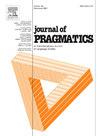标记语调作为语音隐喻的系统功能研究
IF 1.8
1区 文学
0 LANGUAGE & LINGUISTICS
引用次数: 0
摘要
罗伯特·维尔特曼(Robert Veltman)将标记语调解释为语音隐喻,类比于语法隐喻。然而,从那时起,语音隐喻的概念就没有得到学术界的重视。在此背景下,本文基于Gerard O’grady的语调分层模型,即语调位于内容平面,并通过对“未标记/标记”和“一致/隐喻”的概念比较,考察标记语调是否作为隐喻以及如何作为隐喻。从上下两方面看,标记语调具有“多形”(即一种意义映射到多种形式)和“多义”(即一种形式映射到多种意义)的隐喻特性,与语法隐喻具有层间张力的功能机制。本文进一步展示了在保护视频中标记语气的使用,说明了它如何传达类似于情绪的语法隐喻的人际意义。综上所述,标记语调在内容层面起着语音隐喻的作用。本研究探索了语音隐喻这一新兴领域,并可能有助于扩展系统功能语法中隐喻的框架,该框架解决了形式与意义相互作用的核心问题。本文章由计算机程序翻译,如有差异,请以英文原文为准。
Marked intonation as a phonological metaphor: A systemic functional approach
Robert Veltman interpreted marked intonation as a phonological metaphor, drawing an analogy to the grammatical metaphor. However, since then, the concept of phonological metaphor has not received significant scholarly attention. In this context, based on Gerard O'Grady's stratification model where intonation is located at the content plane, and notional comparison of “Unmarked/marked” and “Congruent/metaphorical”, the current paper examines whether and how marked intonation works as a metaphor. It argues that marked intonation parallels grammatical metaphor with the functional mechanism of inter-stratal tension as it carries metaphorical properties of “poly-form” (i.e. one meaning maps to more than one form) and “poly-seme” (i.e. one form maps to more than one meaning) when seen respectively from above and below. The paper further demonstrates the use of marked tone within a conservation video, illustrating how it conveys interpersonal meanings akin to the grammatical metaphor of mood. In conclusion, marked intonation serves as a phonological metaphor at the content plane. This study explores the emerging area of phonological metaphor and probably contributes to expanding the framework of metaphor in Systemic Functional Grammar which addresses a core issue in the interplay between form and meaning.
求助全文
通过发布文献求助,成功后即可免费获取论文全文。
去求助
来源期刊

Journal of Pragmatics
Multiple-
CiteScore
3.90
自引率
18.80%
发文量
219
期刊介绍:
Since 1977, the Journal of Pragmatics has provided a forum for bringing together a wide range of research in pragmatics, including cognitive pragmatics, corpus pragmatics, experimental pragmatics, historical pragmatics, interpersonal pragmatics, multimodal pragmatics, sociopragmatics, theoretical pragmatics and related fields. Our aim is to publish innovative pragmatic scholarship from all perspectives, which contributes to theories of how speakers produce and interpret language in different contexts drawing on attested data from a wide range of languages/cultures in different parts of the world. The Journal of Pragmatics also encourages work that uses attested language data to explore the relationship between pragmatics and neighbouring research areas such as semantics, discourse analysis, conversation analysis and ethnomethodology, interactional linguistics, sociolinguistics, linguistic anthropology, media studies, psychology, sociology, and the philosophy of language. Alongside full-length articles, discussion notes and book reviews, the journal welcomes proposals for high quality special issues in all areas of pragmatics which make a significant contribution to a topical or developing area at the cutting-edge of research.
 求助内容:
求助内容: 应助结果提醒方式:
应助结果提醒方式:


